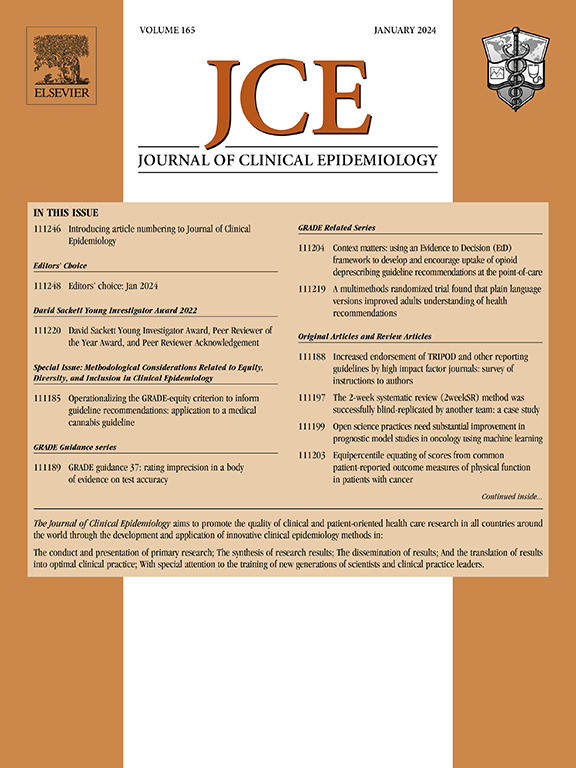When and why to use overlap weighting: clarifying its role, assumptions, and estimand in real-world studies
IF 5.2
2区 医学
Q1 HEALTH CARE SCIENCES & SERVICES
引用次数: 0
Abstract
Objectives
To examine the strengths and limitations of overlap weighting in observational studies and to clarify when it is appropriate to use this method based on the target estimand.
Study Design and Setting
This is a narrative commentary that reviews recent methodological developments and real-world examples to highlight how overlap weighting operates, when it provides advantages over methods like inverse probability of treatment weighting, and the importance of aligning analytic methods with the causal question and estimand.
Results
Overlap weighting produces bounded, stable weights and achieves exact mean covariate balance in the subset of patients with overlapping treatment probabilities near 0.5—those considered to be in clinical equipoise. However, it targets the average treatment effect in the overlap population (ATO), a statistically defined subgroup that is difficult to characterize clinically. Use of this method without prespecifying interest in the ATO may lead to misinterpretation of results. While overlap weighting improves statistical performance, it limits generalizability and interpretability. Study design and inclusion/exclusion criteria remain critical for addressing violations of positivity.
Conclusion
Overlap weighting is most appropriate when the research question explicitly targets the overlap population. It should not be adopted solely to resolve estimation issues with average treatment effect or average treatment effect in the treated methods. Researchers must define their target estimand before choosing a method and clearly report the characteristics of both the unweighted and overlap-weighted populations to ensure valid causal inference.
Plain Language Summary
Overlap weighting is a statistical method used in health research to compare treatments when people are not randomly assigned to different options. It focuses on patients who could realistically receive either treatment and helps improve the fairness and precision of comparisons. However, the results apply only to this specific group and not everyone in the study. Researchers should choose this method only when it fits the question they are asking.

何时以及为什么使用重叠加权:澄清其在现实世界研究中的作用、假设和估计。
目的:探讨重叠加权在观察性研究中的优势和局限性,并根据目标估计阐明何时适合使用该方法。研究设计和设置:这是一篇叙述性评论,回顾了最近的方法发展和现实世界的例子,以强调重叠加权是如何运作的,当它比IPTW等方法提供优势时,以及将分析方法与因果问题和估计结合起来的重要性。结果:重叠加权产生有界的、稳定的权重,并在重叠治疗概率接近0.5的患者子集中实现精确的平均协变量平衡,这些患者被认为处于临床均衡状态。然而,它针对的是重叠人群(ATO)的平均治疗效果,这是一个统计学上定义的亚组,难以在临床上表征。使用这种方法而不预先指定对ATO的兴趣可能导致对结果的误解。虽然重叠加权提高了统计性能,但它限制了概括性和可解释性。研究设计和纳入/排除标准仍然是解决违反积极性的关键。结论:当研究问题明确针对重叠人群时,重叠加权是最合适的。它不应该仅仅用于解决使用ATE或ATT方法的评估问题。研究人员必须在选择方法之前确定目标估计,并清楚地报告未加权和重叠加权人口的特征,以确保有效的因果推断。
本文章由计算机程序翻译,如有差异,请以英文原文为准。
求助全文
约1分钟内获得全文
求助全文
来源期刊

Journal of Clinical Epidemiology
医学-公共卫生、环境卫生与职业卫生
CiteScore
12.00
自引率
6.90%
发文量
320
审稿时长
44 days
期刊介绍:
The Journal of Clinical Epidemiology strives to enhance the quality of clinical and patient-oriented healthcare research by advancing and applying innovative methods in conducting, presenting, synthesizing, disseminating, and translating research results into optimal clinical practice. Special emphasis is placed on training new generations of scientists and clinical practice leaders.
 求助内容:
求助内容: 应助结果提醒方式:
应助结果提醒方式:


